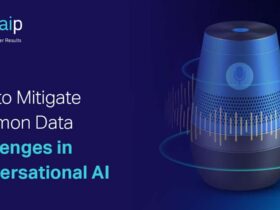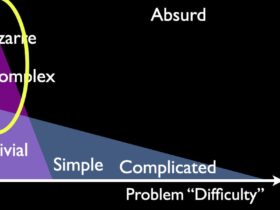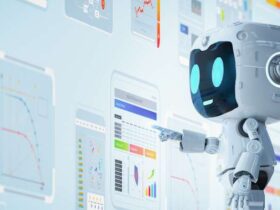Aicorr.com dives into the question of what is noise in data. The team explores the concept, types, causes, impact on ML models, and tackling methods.
Table of Contents:
Data Noise
In data science and machine learning, the pursuit of meaningful insights often encounters an obstacle: noise in data. Noise refers to irrelevant, random, or misleading information within a dataset that does not accurately represent the true underlying patterns. Hence, identifying and managing noise is essential, as it can distort results, reduce predictive accuracy, and complicate the training of machine learning models. In this content, the team of AICorr will examine the nature of noisy data, the impact it has on machine learning, and strategies for addressing it.
What Is Noise in Data?
In data science, noise encompasses any type of unwanted information that interferes with the detection of accurate patterns in a dataset. Noise can occur in various forms, from random errors to systematic biases, and its presence often means that algorithms struggle to identify the true patterns within the data. This issue is especially prominent in machine learning, where the goal is to teach algorithms to recognise patterns and make accurate predictions. By misguiding the algorithm, noise can degrade the model’s performance and lead to inaccurate or unreliable results.
Types of Noisy Data
Understanding the different types of noise in data helps data scientists and machine learning practitioners devise effective strategies to deal with it. Below we explore some of the most common types of noise.
Random Errors
Random noise occurs from accidental fluctuations during data collection or measurement. These errors are often unpredictable and can arise from minor environmental changes, human oversight, or even limitations of the measurement tools themselves. For example, slight fluctuations in sensor measurements can introduce randomness into temperature data, which is a classic case of random noise.
Outliers
Outliers are data points that significantly deviate from the majority of the data. While some outliers are valid data points, they can often be indicative of errors or irrelevant information. If not addressed, outliers can skew averages and interfere with the learning process in machine learning models. For instance, in a survey dataset, a reported age of 200 years would likely be an error or prank and is considered noise.
Irrelevant Features
Not all features in a dataset contribute to the prediction of a target variable. When irrelevant features are included, they can act as noise by adding unnecessary information, which can confuse the model and reduce accuracy. For instance, if a dataset predicting vehicle fuel efficiency includes the color of the car as a feature, it is likely irrelevant and introduces unnecessary noise.
Systematic Errors or Bias
Systematic errors, unlike random errors, follow a specific pattern. They are often caused by consistent inaccuracies in measurement tools or data collection methods. Systematic noise can be particularly tricky to handle because it may not appear random at all. A calibration issue with a scale that consistently adds 2 kg to weights, for example, would introduce a consistent bias or error into the data, representing systematic noise.
Human Errors
Human mistakes, such as typos or transcription errors, can introduce noise into data. These errors often arise during manual data entry or transcription and can be a source of significant inaccuracies, especially in large datasets. For instance, recording an individual’s income as 100,000 instead of 10,000 is a typical human error that introduces noise.
Causes of Noise
Noise can enter data through numerous places.
- Measurement Inaccuracies: Imperfections in data-collecting instruments or methods can lead to inconsistent measurements. Tools such as sensors or scales may fluctuate slightly, especially under different environmental conditions, leading to noisy data.
- Environmental Factors: In data collection processes involving physical sensors, environmental conditions like temperature, humidity, or lighting can introduce variations.
- Data Transmission Errors: Errors during data transfer from one system to another can introduce noise, especially if there is data loss or corruption.
- Data Entry Errors: Manual data entry is especially prone to typos and transcription errors, which can add noise to the dataset.
- Sampling Errors: Poor sampling methods, where the data does not accurately represent the whole population, can introduce bias and noise.
Impact of Noise on Machine Learning Models
The presence of noise can greatly affect the performance of machine learning models, resulting in several issues. Let’s explore the major 3 problems of data noise.
- Reduced Model Accuracy
- Noise in data can mislead a machine learning model, causing it to learn inaccurate patterns or relationships. This reduces the overall accuracy of the model, leading to poor performance on both training and testing datasets.
- Overfitting
- In machine learning, overfitting occurs when a model learns the details and noise in the training data to the extent that it negatively impacts the model’s performance on new, unseen data. When a model becomes overly sensitive to noise, it may perform well on the training dataset but poorly on new data, as it has essentially “memorised” the noise.
- Increased Complexity
- Noise can make data patterns more complex, requiring more sophisticated algorithms to detect true relationships. This leads to increased computational costs and can make models harder to interpret and more prone to error.
Techniques for Handling Noise
Managing noise is a crucial step in data preprocessing. There are several techniques that can help minimize its impact.
1. Data Cleaning
Data cleaning is the process of identifying and removing inaccuracies in the dataset, such as outliers and irrelevant features. Techniques include outlier detection methods like the Z-score or interquartile range (IQR) and handling missing values with imputation methods.
2. Feature Selection
Irrelevant features add unnecessary information to a model and should be removed through feature selection techniques. Methods like correlation analysis, recursive feature elimination (RFE), and principal component analysis (PCA) can help identify and eliminate irrelevant features, reducing noise.
3. Smoothing Techniques
In time-series or signal data, smoothing techniques like moving averages and exponential smoothing can help reduce random fluctuations, making underlying trends more visible.
4. Robust Algorithms
Certain machine learning algorithms are inherently more robust to noise. For example, decision trees and ensemble methods like Random Forests are more resistant to outliers compared to linear models. These algorithms can help mitigate the impact of noise without needing extensive data cleaning.
5. Regularisation
Regularisation techniques, such as Lasso or Ridge regression, can prevent a model from becoming overly complex and overfitting noisy data. By penalising large coefficients, regularisation helps prevent models from adapting too closely to noisy data points.
The Bottom Line
Noisy data is a common and often unavoidable issue in data science and machine learning. As a result, presenting one of the biggest challenges to developing accurate models. By understanding the types of noise—such as random errors, outliers, irrelevant features, systematic errors, and human mistakes—data scientists can select appropriate techniques to address it. From data cleaning and feature selection to using robust algorithms and regularisation, effective noise management is essential for improving model performance and reliability.
Noise cannot always be entirely removed. But by reducing it as much as possible, we can enhance the accuracy of our models and gain better insights from our data. The field of machine learning continues to advance. Therefore, effective noise-handling strategies will remain essential to building reliable, high-performance models capable of making accurate predictions.












